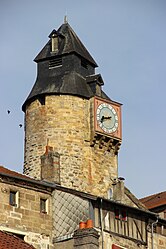
Back Bar-le-Duc Afrikaans Bar-le-Duc AN بار لو دوك Arabic بار لو دوك ARZ Bar-le-Duc AST بار-لو-دوک AZB Бар-ле-Дзюк Byelorussian Bar-le-Duc Breton Bar-le-Duc Catalan БагӀ-лоь-Дуьк CE
This article needs additional citations for verification. (February 2012) |
Bar-le-Duc | |
|---|---|
Prefecture and commune | |
 Clock tower | |
| Coordinates: 48°46′19″N 5°09′37″E / 48.7719°N 05.1603°E | |
| Country | France |
| Region | Grand Est |
| Department | Meuse |
| Arrondissement | Bar-le-Duc |
| Canton | Bar-le-Duc-1 and 2 |
| Intercommunality | CA Bar-le-Duc - Sud Meuse |
| Government | |
| • Mayor (2020–2026) | Martine Joly[1] (UDI) |
Area 1 | 23.62 km2 (9.12 sq mi) |
| Population (2022)[2] | 14,615 |
| • Density | 620/km2 (1,600/sq mi) |
| Time zone | UTC+01:00 (CET) |
| • Summer (DST) | UTC+02:00 (CEST) |
| INSEE/Postal code | 55029 /55000 |
| Elevation | 175–327 m (574–1,073 ft) (avg. 240 m or 790 ft) |
| 1 French Land Register data, which excludes lakes, ponds, glaciers > 1 km2 (0.386 sq mi or 247 acres) and river estuaries. | |
Bar-le-Duc (French pronunciation: [baʁ lə dyk] ⓘ), formerly known as Bar, is a commune in the Meuse département, of which it is the capital. The department is in Grand Est in northeastern France.[3]
The lower, more modern and busier part of the town extends along a narrow valley, shut in by wooded or vine-clad hills, and is traversed by the Ornain, which is crossed by several bridges. It is bordered on the north-east by the Marne–Rhine Canal and on the south-west by a small arm of the Ornain called the Canal des Usines, on the left bank of which the upper town (Ville Haute) is situated.[4]
The highly rarefied Bar-le-duc jelly, also known as Lorraine jelly, is a spreadable preparation of white currant or red currant fruit preserves. First mentioned in the historical record in 1344, it is also colloquially referred to as "Bar caviar".
- ^ "Répertoire national des élus: les maires" (in French). data.gouv.fr, Plateforme ouverte des données publiques françaises. 6 June 2023.
- ^ "Populations de référence 2022" (in French). The National Institute of Statistics and Economic Studies. 19 December 2024.
- ^ INSEE commune file for Bar-le-Duc
- ^ One or more of the preceding sentences incorporates text from a publication now in the public domain: Chisholm, Hugh, ed. (1911). "Bar-le-Duc". Encyclopædia Britannica. Vol. 3 (11th ed.). Cambridge University Press. p. 404.



